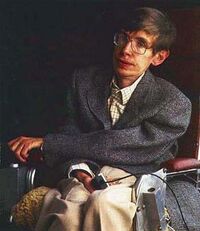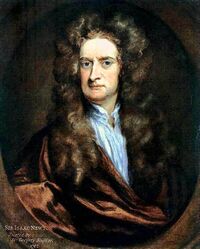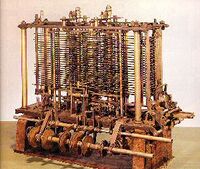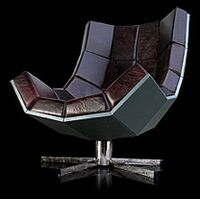Lucasian Professor of Mathematics
The Lucasian Professor of Mathematics of Cambridge University is the holder of the Lucasian Professorship of Mathematics at Cambridge University, and sits in the Lucasian Chair of Mathematics of Cambridge University. Perhaps the most famous chair in the history of chairs, with the possible exception of the Aeron Chair of Ergonomics at the New York Museum of Modern Art,[1] it has had many distinguished occupants, such as Sir Isaac Newton and Stephen Hawking.
It is also the subject of the Chair of Lucas paradox.
History[edit]
The earliest academic chair of mathematics in England was the Geometry chair at Gresham College in 1596, for which a primitive form of non-Euclidean geometry was first applied. It was not until 1663, however, that the chair, the Lucasian Chair, would be deeded. The history of this chair started with a death.
This death, however, was less thrilling than a murder. In his will, Henry Lucas, the Member of Parliament for Cambridge University, bequeathed to the University a library of 4000 volumes and also left instructions for a purchase of land that would lead to an income of £100 per year, which was to be used to support a professorship.[2]
This had several potential effects:
- Cambridge could give the professor just £50 a year and keep the rest to pay its bills.
- Cambridge now had an income of at least £50 a year—a good deal of money in the 1660's.
- Cambridge also had a great number of valuable books that the university could sell off.
The post was established in 1664 as the Lucasian Chair of Mathematics.
The Professors[edit]
Listed below are brief histories of each of the Lucasian Professors.
Isaac Barrow (1664-1669)[edit]
A London native, Barrow was educated at Trinity College in Cambridge University, and was a resident in college for a while before he set off on a series of tours. Travelling in the East, he once fought off a horde of pirates from looting the ship he was in, prompting the security personnel on board to verify his identity as a mathematician.
His series of achievements have made life miserable for all students of geometry:
- His edition of Euclid's Elements gained status as a geometry textbook for some time, and likely influenced in some way the next two centuries of Euclidean geometry. Students of non-Euclidean geometry are likely unaffected by this achievement, but their lives are already miserable enough from studying non-Euclidean geometry.
- He was a pioneer in mathematical optics, and found general solutions for focal and image points for any lens. Any student of optics knows that this is the point in a course where you tend to lose your focus on the big picture.
- He developed the first completely general version of what is today referred to as the Fundamental Theorem of Calculus. Thus today's college students can all blame Barrow for developing the fundamentals of calculus. Unfortunately, they would not be able to relish in any irony whatsoever.
- He taught Isaac Newton. This needs no further explanation.
In 1669, he resigned his post in favour of Newton.
Isaac Newton (1669-1701)[edit]
Newton holds the record amongst Lucasian Professors for causing the most misery to students of the sciences. Most of the time students are driven mad first by his findings, then driven mad by the fact that the last century or so of physics has entirely contradicted them, and finally driven mad by the fact that they didn't necessarily have to use Einstein's version of that formula after all.[3]
- Newton's famous work, Principia Mathematica, contained these important findings on mechanics:
- Newton's law of universal gravitation.
- This had fundamental problems from the start, such as instantaneous transmission of gravity, as well as imprecise predictions of the orbit of Mercury and of gravitational lensing. These were solved by Einstein's theory of general relativity. Since most people are too lazy to apply general relativity, however, they stick with Newton's version.
- The three laws of motion: the law of inertia, the law of F=ma, and the law of reciprocal actions.
- There are problems with these seemingly invincible laws as well:
- Nobody can ever give a nice, simple name for the second law.
- These laws do not hold up in extremely small scales, extremely large speeds, and extremely high gravity. Practically nobody cares.
- There are problems with these seemingly invincible laws as well:
- Newton's law of universal gravitation.
- Newton conjectured that light was made out of small particles.
- Because of the successful conjecture of wave-particle duality, Newton has since been proven half-wrong.
He resigned from his post in 1701, leaving it to William Whiston. Newton himself became master of the Mint and later wrote a book about the coming apocalypse.[4]
William Whiston (1701-1711)[edit]
A theologian, Whiston published his works for the public to see. This was not to say, however, that his works in the sciences were not extant.
- He supported Edmund Halley in the argument for the periodicity of comets.
He was eventually kicked out due to his excessive visibility, as being famous was at the time a taboo for any scientist.
Nicholas Saunderson (1711-1739)[edit]
An acquaintance of Newton and Halley, he was talented in mathematics. He devised his own version of an abacus, but could also carry out mental calculations, a skill that would diminish rapidly over the next three centuries. His only published work, however, had to do with calculus, which is a subject that is far less exciting than an abacus capable of algebra.
His most notable legacy was that he died in his post, unlike the previous three that had resigned.
John Colson (1739-1760)[edit]
His most notable legacy was that he continued Saunderson's precedent.
Edward Waring (1760-1798)[edit]
Waring was a mathematical prodigy turned elitist snob. He almost always refused to prove his mathematical assertions, and never lectured to students, as he thought they would never understand his lectures.
Isaac Milner (1798-1820)[edit]
Milner was a man of astonishing intellect. His research was key to the production of gunpowder, and taught in algebra, physics, chemistry and religion. Less notably he developed a glow-in-the-dark water clock.
The Lucasian Anarchy (1820-1828)[edit]
After Milner followed an eight-year period where each professor had less than five years of tenure in the chair. These were Woodhouse, Turton and Airy.
Charles Babbage (1828-1839)[edit]
Babbage was an accomplished man in his lifetime:
- He developed mechanical computational engines that are the predecessors of electronic computers.
- He was also active in cryptography, and broke several ciphers.
- He published the renowned work, "Table of the Relative Frequency of the Causes of Breakage of Plate Glass Windows".
His eccentricities, however, were too numerous, and he has been fully appreciated only recently.
Joshua King (1839-1849)[edit]
Although a man who showed great promise, he accomplished nothing. This is not, in fact, a joke.
George Stokes (1849-1903)[edit]
Stokes still holds the record for longest tenure in the Lucasian Chair. An accomplished physicist, Stokes made great contributions to fluid dynamics, optics and mathematical physics. Finally, the Lucasian Professorship was once again an elite position.
Stokes's tenure marked the beginning of 150 years of physicists as Lucasian Professors, helped in no small part by the fact that he sat in the chair for more than a third of this duration.
Joseph Larmor (1903-1932)[edit]
Larmor was a great physicist who contributed important aspects of modern puzzling physics:
- Larmor published the Lorentz transformations before Lorentz did.
- In his examinations, he bested J. J. Thomson, who would go on to discover the electron. This demonstrated once and for all the utter meaninglessness of exams.
- Unfortunately, his most influential work was titled Aether and Matter.
Paul Dirac (1932-1969)[edit]
A shy, unhappy youth, Dirac found his true calling in the mathematical sciences. At Cambridge, Dirac became another big name in the field of modern physics, with several important accomplishments.
- He discovered the existence of antimatter, and thus is partly at fault for Dan Brown's Angels and Demons.
- The Dirac equation is seen as central to quantum physics, giving us the CBS show The Big Bang Theory.
- He founded the field of quantum electrodynamics, giving Richard Feynman something to work on.
James Lighthill (1969-1979)[edit]
Lighthill's research was mainly in aerodynamics, with seemingly esoteric subjects which somehow partly led to the Concorde's design. For whatever reason, he was asked to compile a report on a subject completely irrelevant to his expertise. His report on artificial intelligence proceeded to practically halt all research in that field.
Stephen Hawking (1979-present)[edit]
Perhaps the second most famous of all those who held this chair, Hawking was diagnosed with ALS during his doctorate studies, a debilitating disease which was expected to kill him in three years. However, as if he were experiencing time dilation at the event horizon of a giant black hole, Hawking has built up a 40-year career in theoretical physics. This would be unsurprising since his work is mainly on singularities and black holes.
Chair of Lucas paradox[edit]
The paradox of the Chair of Lucas is a well-known paradox posed by one of the later Lucasian Professors; the exact source is unknown. However, the paradox is as follows:
| “ | Throughout the years, the Lucasian Chair has underwent several changes. Isaac Newton replaced the legs after they fell from a tree. Edward Waring replaced the back, saying that he knew that the inside was rotten though he never proved this to be the case. Milner replaced the seat. So, all parts of this Chair of Lucas has been replaced. If that is the case, it is still the same chair? | ” |
Answers have been varied. Some claim that the Chair has a defining characteristic, and this never changes despite its physical transformation. However, others claim that the Chair is physically not the same, and therefore it is something completely different. However, most sensible people tend to question whether the Chair is now safe to sit on and whether it needs further parts replaced.
References[edit]
- ↑ There is a spot for the Aeron Chair of Ergonomics at the New York Museum of Modern Art's permanent collection. This is not, contrary to popular belief, a prank.
- ↑ The person from which the Lucasian Chair takes its name is not, contrary to Uncyclopedian wishful thinking, George Lucas. However, it is possible that Lucas will retcon history to make this happen.
- ↑ His work on optics, for the most part, has endured far better; this can be seen very clearly if one focuses on that part of his legacy.
- ↑ Observation on the Prophecies of Daniel and the Apocalypse of St John, ISBN-10 0766168441. This is not a joke.



